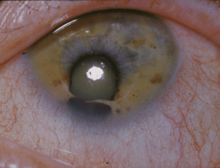Cat eye syndrome
Not to be confused with Heterochromia, an optical condition which is commonly associated with cats
| Cat-eye syndrome | |
|---|---|
| Other names | CES[1] |
 | |
| An example of the defect after which CES is named | |
| Specialty | Medical genetics |
| Frequency | 1 in 74,000 |
Cat-eye syndrome (CES) or Schmid–Fraccaro syndrome is a rare condition caused by an abnormal extra
Signs and symptoms
- Unilateral or bilateral iris coloboma (absence of tissue from the colored part of the eyes)
- Preauricular pits/tags (small depressions/growths of skin on the outer ears)

- Anal atresia(abnormal obstruction of the anus)
- Downward-slanting palpebral fissures(openings between the upper and lower eyelids)
- Cleft palate
- Kidney problems (missing, extra, or underdeveloped kidneys)
- Short stature
- Scoliosis/skeletal problems
- Cardiac defects (such as TAPVR)
- Micrognathia(smaller jaw)
- Hernias
- Biliary atresia[5]
- Rarer malformations can affect almost any organ
- Intellectual disability – many are intellectually normal; about 30% of CES patients have moderately impaired mental development, although severe intellectual disability is rare.[6]
The term "cat eye" syndrome was coined because of the particular appearance of the vertical colobomas in the eyes of some patients, but over half of the CES patients in the literature do not present with this trait.[6]
Genetics
The small supernumerary marker chromosome (sSMC) in CES usually arises spontaneously. It may be hereditary and parents may be mosaic for the marker chromosome, but show no
Diagnosis
This section is empty. You can help by adding to it. (April 2022) |
An ultrasound exam may be used by a doctor to detect a birth defect that might be CES before a baby is born. An ultrasound creates an image of the fetus using sound waves. It might uncover specific CES-specific flaws. A follow-up test, like an amniocentesis, may be ordered by the doctor if they see these characteristics on an ultrasound. The doctor collects an amniotic fluid sample for analysis during amniocentesis. Extra chromosomal material from chromosome 22q11 helps doctors identify CES. The diagnosis can be verified through genetic testing. These tests could consist of:
- Karyotyping. A picture of a person's chromosomes is generated by this test.
- FISH, or fluorescence in situ hybridization. It is able to identify and pinpoint a particular DNA sequence on a chromosome.
The healthcare provider will likely order more testing when CES is identified to look for any potential extra problems, like heart or kidney disorders. These tests may include:[medical citation needed]
- X-rays and other imaging tests
- electrocardiography (EKG)
- echocardiography
- eye examination
- hearing tests
- cognitive function tests
History
The abnormalities common to CES were first cataloged in 1899,[10] and described in association with a small marker chromosome in 1965.[11] Early reports of CES discuss the possibility of chromosome 13 involvement. Now, CES is considered to be present with the chromosome 22 trisomy findings.[12]
See also
References
- ^ "Cat eye syndrome". Orphanet. Retrieved 20 March 2019.
- ^ PMID 26322288.
- PMID 11693792.
- ^ "Cat eye syndrome | Genetic and Rare Diseases Information Center (GARD) – an NCATS Program".
- ^ Congenital bile duct anomalies (biliary atresia) and chromosome 22 aneuploidy. Allotey J, Lacaille F, Lees MM, Strautnieks S, Thompson RJ, Davenport M. J Pediatr Surg. 2008 Sep;43(9):1736-40. doi: 10.1016/j.jpedsurg.2008.05.012.
- ^ a b "Disorders of chromosome 22: Cat Eye Syndrome/Schmid Fraccaro Syndrome". www.c22c.org. Chromosome 22 Central. 18 July 2017. Retrieved 22 December 2017.
- ^ "Cat eye syndrome | Genetic and Rare Diseases Information Center (GARD) – an NCATS Program". rarediseases.info.nih.gov. Retrieved 17 April 2018.
- PMID 33318309.
- PMID 22395867.
- Archives of Ophthalmology, 24: 257 only, 1879
- PMID 14330081.
- S2CID 35284790.
